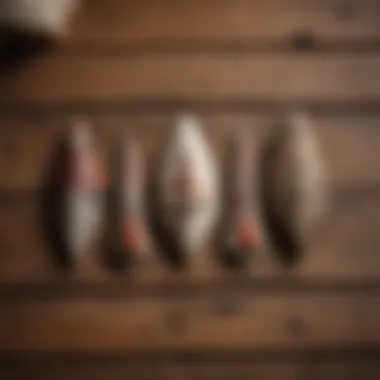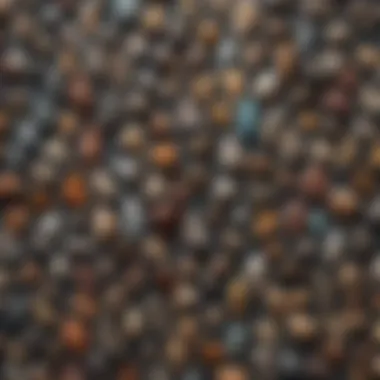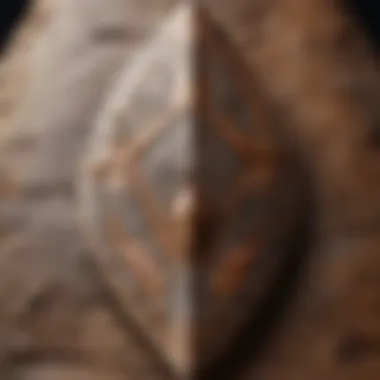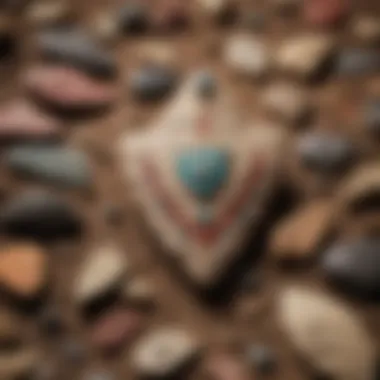Native American Arrowheads: A Collectors Guide


Intro
The allure of Native American arrowheads extends beyond their utility; they embody a rich tapestry of history and cultural significance. Collectors and enthusiasts seek them not only for their beauty but also for the stories they tell about the people who once used them. Understanding the nuances of these artifacts is key to appreciating their place in both history and contemporary collecting culture.
In this guide, we delve into the complexities involved in purchasing Native American arrowheads, focusing on essential aspects from authentication to valuation. This exploration serves to provide collectors with a deeper understanding of the marketplace and the artifacts themselves.
Understanding Native American Arrowheads
Native American arrowheads represent more than just tools of ancient survival; they serve as a bridge to understanding cultural practices, historical movements, and the artistry of Native American tribes. Exploring the facets of arrowheads is crucial for any collector or history enthusiast seeking to grasp the significance of these artifacts. They embody a connection to the land, the people who inhabited it, and the skills developed through generations. By understanding arrowheads, individuals can appreciate their beauty, the stories they tell, and the traditions they continue to represent.
Historical Context
The history of Native American arrowheads is intertwined with the lifeways of various tribes across North America. Arrowheads date back thousands of years, serving as essential tools for hunting and warfare. Each region's unique geology influenced the materials used, resulting in a rich variety of styles, shapes, and sizes. Commonly crafted from flint, obsidian, or quartz, these materials not only offered durability but also cultural expression.
Archaeological studies show that certain types of arrowheads appear in different time periods, representing shifts in technology and adaptation to surroundings. For example, the Folsom point, characterized by its unique fluting, reveals insights into early hunting techniques and migration patterns. This historical context helps collectors identify and categorize arrowheads, fostering a deeper appreciation for the skill and knowledge held by indigenous craftsmen.
Cultural Significance
Beyond their functional use, arrowheads have cultural significance that reflects the values and beliefs of Native American tribes. For many tribes, arrowheads hold spiritual and ceremonial importance. They are often seen as symbols of strength and resilience, embodying the spirits of ancestors who relied on them for survival.
Additionally, arrowheads can represent artistry. Craftsmen paid great attention to the aesthetics of their creations. The designs and techniques varied significantly among tribes, each conveying a visual language. Understanding these cultural aspects allows collectors to engage more meaningfully with their acquisitions, appreciating not only the craftsmanship but the rich tapestry of stories that each piece represents.
"Collecting arrowheads is not just about the artifacts themselves; it is about honoring the history and cultures behind them."
By studying the historical and cultural significance of Native American arrowheads, collectors can cultivate a more profound respect for these objects as dynamic representations of heritage, adaptability, and human ingenuity.
Collecting Arrowheads
Collecting arrowheads offers a unique blend of history, culture, and personal connection. Each arrowhead tells a story, reflecting the life and skills of the indigenous peoples who crafted them. For enthusiasts, this is not merely a hobby but a passion that cultivates respect for the past and an appreciation for craftsmanship.
The act of collecting arrowheads can be deeply satisfying. It encourages exploration, as collectors often travel to different regions to find unique pieces. Each location has its own rich history and potential for discovery, making the journey to uncover these artifacts as exciting as owning them. Whether one collects for aesthetic purposes, historical significance, or investment, the motivations can greatly vary.
As with any collecting activity, understanding the nuances of the market is crucial. Factors such as material, age, and condition all play significant roles in the value of arrowheads. Knowledge about these aspects helps collectors make informed decisions when adding to their collections.
Additionally, engaging with fellow collectors can enhance the experience. Sharing knowledge, trading, or simply discussing favorite finds fosters a sense of community. Online platforms and local shows are excellent venues for connecting with others who share the same interest.
Ultimately, collecting arrowheads is about more than just possession. It is an avenue for education, connection, and appreciation of indigenous cultures.
Why Collect Arrowheads?
Collecting arrowheads serves several purposes. It acts as a preservation of history, allowing collectors to safeguard artifacts that might otherwise be lost. Many arrowheads originate from different tribes, each with distinct styles and materials, reflecting the diversity of Native American craftsmanship.
Here are some reasons why enthusiasts choose to collect:
- Historical Preservation: Collectors play a role in preserving tangible links to the past.
- Cultural Appreciation: Understanding the cultural significance behind each piece fosters a respect for Native American traditions.
- Investing in Artifacts: High-quality, rare arrowheads can appreciate in value, making them potential investments.
- Personal Connection: For many, finding arrowheads in the wild adds a fulfilling aspect to their collecting experience.
As arrowheads tell the stories of the people who made them, they foster connections across time and culture.
Identifying Best Practices
Collecting arrowheads requires informed strategies to ensure responsible and successful acquisition. Here are some best practices to consider:


- Research Thoroughly: Familiarize yourself with the various types, styles, and materials used in arrowhead making. Books, online resources, and community groups offer valuable insights.
- Respect Local Laws: Understand your local laws regarding artifact hunting and collecting. Some sites may be protected, and removing artifacts could have legal consequences.
- Seek Authenticity: When purchasing, verify the authenticity of the pieces. Engage reputable sellers or auction houses specializing in Native American artifacts.
- Network with Other Collectors: Join local or online collecting clubs. These platforms can provide helpful tips and recommendations from experienced collectors.
- Share Knowledge: Be open to learning from others. Sharing experiences not only enhances personal growth but also fosters a community spirit among collectors.
- Practice Ethical Collecting: Always approach collecting with respect for Native American cultures. Understand the historical context behind the artifacts before adding them to your collection.
By implementing these best practices, collectors can navigate the complex landscape of arrowhead collecting with care and responsibility.
Evaluating Authenticity
Evaluating the authenticity of Native American arrowheads is vital for collectors and enthusiasts alike. Genuine artifacts hold significant historical and cultural value, often reflected in their pricing and importance. Misidentifications can lead to unwarranted expenditures on replicas or forgeries, detracting from the integrity of a collection. Therefore, understanding how to distinguish authentic pieces from imitations is paramount.
Understanding Fakes and Reproductions
In the realm of arrowhead collecting, it is crucial to identify the distinction between authentic artifacts and fakes or reproductions. Many factors contribute to the production of imitation arrowheads, including the increased interest in Native American culture and the financial potential of selling collectibles. Some reproductions may look almost identical to genuine artifacts, making it more challenging for collectors to discern the differences.
Factors to consider when identifying fakes include:
- Materials Used: Authentic arrowheads are typically made from stone like flint or obsidian. Fakes may utilize modern materials like glass or plastic.
- Craftsmanship: Genuine artifacts exhibit specific signs of wear and use, while fakes may appear too pristine or uniform.
- Style and Form: Familiarizing oneself with the different types of arrowhead styles can aid in identification. For example, a Mesa Point arrowhead differs greatly from a Dalton point in both form and function.
Collectors must study the characteristics of genuine artifacts, including their historical context and the environments where they were made.
Techniques for Verification
To verify the authenticity of arrowheads, collectors can employ various techniques. Here are some proven methods:
- X-Ray Fluorescence (XRF): This non-destructive technique analyzes the elemental composition of an arrowhead, helping to confirm if it is made from appropriate materials.
- Attrition Analysis: Assessing wear patterns can reveal whether an arrowhead was used or simply a decorative piece. Collectors should look for evidence of hafting, which can indicate genuine use.
- Provenance Documentation: Collectors should seek clear ownership records that trace the artifact's history. Provenance adds credibility and can significantly enhance the value.
"Authenticity verification not only safeguards investments but also honors cultural heritage."
Collectors are encouraged to consult experts or join local clubs for insights on identifying authenticity. Online resources can also offer valuable information, including discussions on platforms like reddit.com or community pages on facebook.com. By employing these techniques, collectors can confidently navigate the market for Native American arrowheads.
Where to Buy Native American Arrowheads
Understanding where to buy Native American arrowheads can deepen the appreciation and enjoyment of collecting these artifacts. Knowing the right places to look not only enhances the chances of finding genuine pieces but also connects collectors with communities and resources. With numerous options available, it is important to be aware of both the benefits and considerations that each purchasing avenue entails.
Online Marketplaces
Online marketplaces offer a vast selection of Native American arrowheads from various sellers. Websites such as eBay, Etsy and specialized antique collecting platforms provide easy access to listings. These platforms allow buyers to browse numerous listings from the comfort of their home. The convenience of shopping online is undeniable; collectors can find everything from simple to intricately crafted arrowheads. Furthermore, many sellers provide detailed descriptions and images, aiding in the evaluation of authenticity and condition.
"Purchasing arrowheads online demands caution. Always verify the seller's reputation before making any transactions."
However, there are challenges in buying through online marketplaces. Not all sellers are reputable, leading to potential risks of acquiring fakes or misrepresented items. Always check seller ratings and read reviews from previous buyers. Utilizing secure payment options is beneficial for safeguarding personal information. It's wise to request additional photographs for a closer look at details such as material, craftsmanship, and any signs of wear.
Buying online can significantly broaden the collection possibilities, but diligence is crucial for a successful experience.
Auction Houses and Collectible Shows
Auction houses and collectible shows provide unique opportunities for collectors to acquire Native American arrowheads. These venues often feature expert appraisals and a curated selection of items, which can lead to significant finds. The environment of a live auction adds excitement and immediacy to the purchasing process, allowing collectors to bid on pieces and potentially secure them at favorable prices.
Collectible shows often bring together collectors, sellers, and knowledgeable enthusiasts, fostering a sense of community. Attending these events can be educational, as many offering opportunities to interact with experts can share invaluable insights into evaluation and care. By participating in discussions, collectors gain information about market trends and items of interest.
When considering purchasing at auction houses or collectible shows, understanding the auction process is key. Bidding requires attentiveness and sometimes quick decision-making. It is advisable to set a budget prior to attending an auction to avoid impulse purchases. Additionally, if you are unfamiliar with the auction format, attending several events as an observer first will help you become comfortable with the atmosphere and process.
Valuation of Arrowheads
Understanding the valuation of Native American arrowheads is essential for collectors and enthusiasts. The value of these artifacts is determined by a range of factors that reflect their historical significance, material quality, and market demand. Knowing how to accurately assess these elements can lead to informed purchasing decisions and a more enriching collecting experience.


Valuation directly impacts the collector's journey. It provides insights into the potential investment value of the arrowhead. A collector who understands valuation can better navigate the marketplace, avoiding overpaying for common pieces.
Furthermore, recognizing valuation helps protect the integrity of the artifact. By discerning its true worth, collectors contribute to ethical collecting practices and cultural respect.
Factors Influencing Value
The value of an arrowhead can be influenced by various specific elements:
- Material: The stone type or material used to create the arrowhead plays a crucial role. Common materials like flint, obsidian, and other high-quality stones often rate higher than those made from less desirable materials.
- Condition: The state of the arrowhead greatly affects its value. Intact pieces with minimal wear or damage tend to attract collectors more than broken or heavily worn items.
- Authenticity: Genuine artifacts hold more value than fakes or reproductions. Provenance adds to this factor, where a documented history enhances the appeal.
- Rarity: Unique designs or styles can significantly elevate an arrowhead's value. Items from specific tribes or geographic regions that are less frequently found are particularly sought after.
- Size and Craftsmanship: Larger pieces or those demonstrating finer craftsmanship are often more valued in the collector market.
Market Trends
The collecting community for Native American arrowheads has seen shifts in market trends over time. Understanding these trends can inform collectors' strategies.
- Growing Interest: There has been an increasing public interest in Native American artifacts, partially due to a broader push for cultural appreciation and preservation. This can lead to higher prices for authentic pieces.
- Online Sales Growth: The rise of online marketplaces has democratized access to rare items, allowing more collectors to participate. Websites such as eBay or specialized collectible sites have become major platforms for buying and selling.
- Auction Houses: Auctions often fetch higher prices for unique artifacts compared to private sales, making them a viable option for serious collectors. More collectors are turning to established auction houses for potentially valuable acquisitions.
- Influence of Social Media: Platforms like Facebook and Reddit have enabled communities to share information and insights on arrowhead collecting, influencing market perceptions and demand.
The valuation discussion provides collectors with essential tools. By understanding various influencing factors and observing market trends, enthusiasts can build a meaningful collection while respecting the artifacts' cultural significance.
Caring for Your Collection
Caring for Native American arrowheads is paramount for any serious collector. These artifacts not only represent a significant part of history but also hold considerable value. Proper care ensures that their integrity, both physical and cultural, is maintained over time. Collectors should prioritize this aspect to preserve the beauty and craftsmanship that these items showcase.
Neglecting to care for these items can lead to deterioration, affecting both their aesthetic appeal and market value. Additionally, it is a responsibility of collectors to show respect to the origins of these arrowheads. A well-kept collection also reflects the seriousness of the collector's commitment to preserving history.
Storage and Display Techniques
When it comes to storing and displaying arrowheads, thoughtful considerations can significantly influence their condition. Arrowheads should be stored in a stable environment, where temperature and humidity are controlled. Ideal conditions are a cool, dry place free from direct sunlight, which can cause fading or damage over time.
Here are some recommended storage methods:
- Use acid-free boxes to protect against environmental damage.
- Utilize padded cases for individual arrowheads to prevent scratches and chips.
- Consider clear display cases that provide visibility while protecting the artifacts. These can be in the form of shadow boxes or display shelves.
It is also important to keep the collection away from high-traffic areas to minimize the risk of accidental damage. Labeling and documenting each piece can help in both care and interest for the collection, allowing collectors to keep an organized record.
Cleaning and Preservation
Cleaning arrowheads is a sensitive process. Improper cleaning can lead to irreversible damage. Therefore, caution should be exercised at all times. Generally, it is advised not to clean the artifacts extensively in many cases; natural patinas and grime can add to their character and authenticity.
If cleaning is necessary, use the following guidelines:
- Use a soft, dry brush to gently remove dust and loose dirt.
- Avoid harsh chemicals and solvents, as these can cause corrosion or discoloration.
- For more stubborn dirt, use a damp cloth with distilled water, ensuring that no moisture penetrates the materials.
Preservation techniques can also enhance the longevity of your collection. Consider using silica gel packets within storage boxes to absorb moisture, which can lead to mold formation. Vacuum sealing is another effective method, though it should be noted that this may not be suitable for all types of arrowheads.
Proper care of your artifacts is not just preservation, but a commitment to history itself. It shows respect for the craftsmanship and stories inherent in each piece.
Ethical Considerations in Collecting
The act of collecting Native American arrowheads transcends mere acquisition; it involves navigating a labyrinth of ethical considerations that honor the rich history and cultural significance of these artifacts. Understanding these ethical dimensions is critical for collectors who wish to engage responsibly with their passion. Not only does this engagement foster a deeper appreciation for Indigenous cultures, but it also ensures the preservation of these important historical objects for future generations.
Cultural Respect and Responsibility
Collecting arrowheads carries a weight of cultural significance that collectors must acknowledge. Native American arrowheads are not just tools; they are remnants of a cultural identity, a connection to ancestral practices, and often, sacred items.


When acquiring arrowheads, it is imperative to respect Indigenous peoples and their heritage. This means avoiding the collection of artifacts that may be grave goods or items of spiritual importance.
Collectors should seek artifacts through reputable sources that ensure ethical practices. Buying items from Indigenous artisans or those who maintain transparent provenance builds a respectful relationship between collectors and the communities tied to these artifacts. By prioritizing cultural respect, collectors can contribute to the sustainability of Indigenous crafts and support their ongoing narratives.
Legal Regulations
The legal landscape governing the collection of Native American artifacts varies greatly. In the United States, laws such as the Native American Graves Protection and Repatriation Act (NAGPRA) establish strict guidelines on the possession and trade of Native American cultural items. This act aims to protect the rights of Indigenous peoples regarding their sacred artifacts and ancestral remains.
Potential collectors must understand and comply with these laws to avoid unintentional legal infringements. This includes being aware of the following:
- Provenance of items: Ensure that your arrowheads come from legitimate sources that respect legal requirements.
- Registration: Some states require collectors to register their collections, especially if they include locally discovered artifacts.
- Resale: Be mindful that selling or trading Native American artifacts may be subject to state-specific regulations that could impact how you share your collection.
"Collecting is not just about ownership but about understanding the historical narrative that these artifacts represent. Ethical considerations are essential to preserve that narrative."
Collecting responsibly not only enriches the collector's experience but also fosters a sense of trust and accountability within the broader community of enthusiasts. Furthermore, by adhering to ethical guidelines and legal requirements, collectors can ensure the longevity of Native American arrowheads and their place within cultural history.
The Future of Arrowhead Collecting
The future of arrowhead collecting is shaped by a number of factors including technological innovation, shifts in collector interests, and the need for responsible stewardship of artifacts. As more people express interest in Native American heritage, understanding these dynamics becomes essential for both seasoned and new collectors. By examining the advancements in technology and the role of community collaboration, collectors can prepare for a changing landscape that embraces authenticity and ethical practices.
Technological Advances in Sourcing
Technological advancements play a pivotal role in the way arrowheads are sourced and authenticated. The integration of data analytics and online databases allows collectors to access a wealth of information about specific types of arrowheads, their origins, and their previous ownership.
Key Developments:
- Digital Platforms: Websites dedicated to Native American artifacts offer extensive cataloging systems, allowing collectors to search for specific items more efficiently.
- 3D Scanning and Printing: This technology can create accurate replicas of original arrowheads, which may enhance educational experiences without compromising the authenticity of actual items.
- Geolocation Services: Modern tools can help identify sourcing locations based on archaeological digs. This increases transparency around where artifacts come from, providing collectors greater confidence.
With these tools, collectors can enhance their knowledge base and ensure their acquisitions are both genuine and ethically sourced.
"As technology evolved, so too did the ability to appreciate and understand the context of collecting. Using advanced tools makes it possible to see beyond the object itself."
Community Engagement and Resources
Community involvement is crucial for the future of arrowhead collecting. Local clubs and online forums provide platforms for enthusiasts to connect, share insights, and promote responsible collection practices.
Benefits of Community Engagement:
- Knowledge Sharing: Participants can exchange tips and databases that encourage informed collecting decisions and a deeper appreciation of the cultural significance behind arrowheads.
- Events and Workshops: Regional events allow collectors to meet experts, attend demonstrations on proper care techniques, and engage in responsible hunting practices.
- Online Resources: Websites like Reddit and Facebook host various groups where individuals can discuss topics related to collecting, marketing trends, and conservation efforts.
Therefore, by leaning into community resources, collectors have the ability to ensure they remain informed about developments in the collecting world while lending their voice to supporting ethical considerations in the acquisition of Native American artifacts.
Ending
In the realm of collecting Native American arrowheads, understanding the various aspects discussed throughout this article is crucial. This conclusion provides a final reflection on the significance of collecting these artifacts and what one might consider as they engage in this hobby. The journey of an arrowhead collector involves not only the appreciation for historical artifacts but also a deep respect for the cultures from which they originate.
Reflections on the Collecting Journey
The collecting journey is personal. Each arrowhead tells a story; its shape, material, and craftsmanship can be a glimpse into the past. As enthusiasts, collectors find themselves entwined with history, learning about the indigenous peoples who crafted these tools for survival. Reflecting on this aspect can deepen one's appreciation for the art involved in arrowhead making. It also serves as a reminder of the broader implications of collection and conservation.
When adding new pieces to a collection, it is essential to remember the stories behind them. Consider the cultural significance attached to these artifacts. Knowledge about the regions they come from or the techniques used for their manufacture enriches the collector's perspective. This reflection can shift the approach from mere accumulation to a more meaningful engagement with history.
Encouragement for New Collectors
New collectors often feel overwhelmed by the intricate details and variances in arrowhead collecting. However, starting this journey is rewarding. Take your time to learn about the history and types of arrowheads available. Begin with local finds, as this can introduce you to the culture and the community surrounding this passion.
Do not hesitate to reach out to seasoned collectors or local clubs focused on Native American artifacts. Online forums such as Reddit provide a wealth of information on different collecting strategies. You will find that many collectors are eager to share insights and experiences that can guide your journey.
As you embark on this venture, remember to practice ethical collecting. This means respecting the cultures associated with these artifacts and adhering to any local regulations. Taking care of your collection and contributing to responsible collecting movements will ensure that arrowheads remain accessible for future generations of collectors and history enthusiasts alike.



